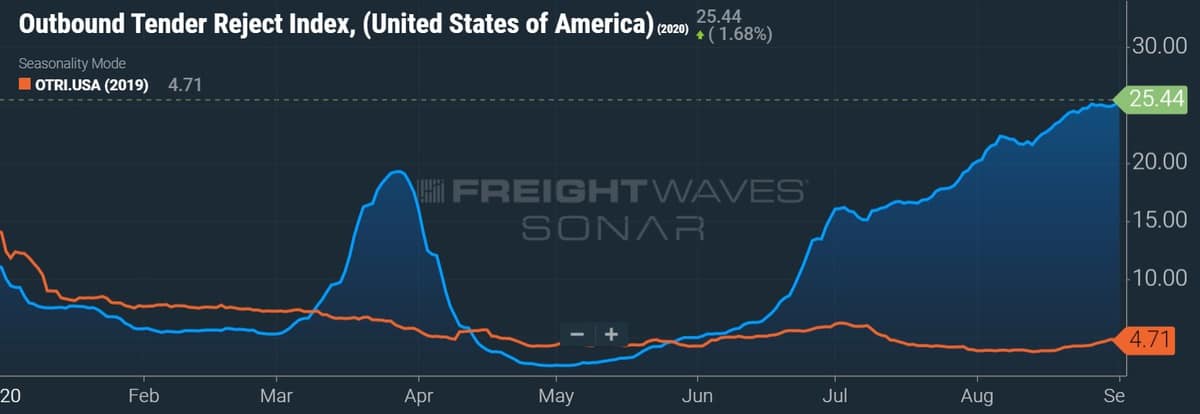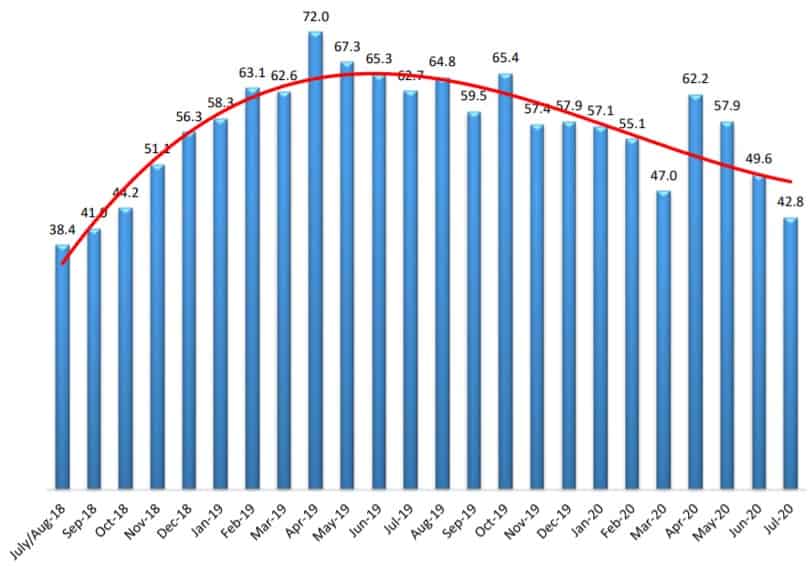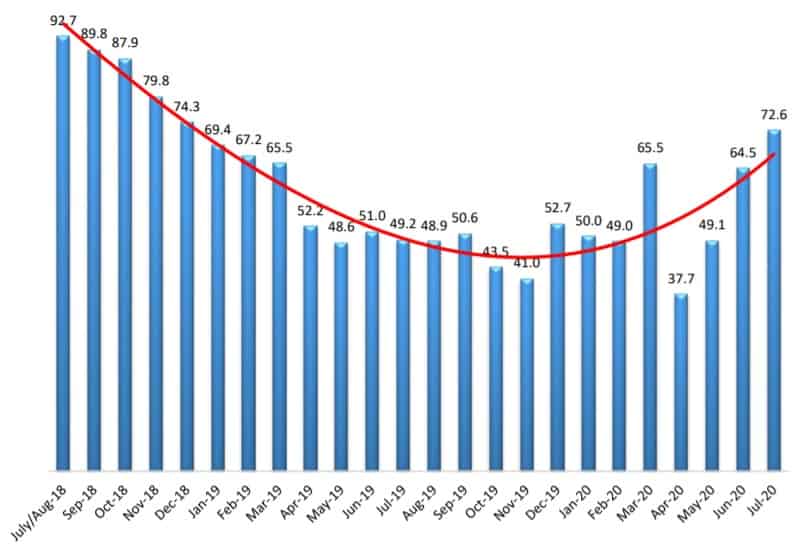Supply chain data shows transportation capacity has declined to a 22-month low with utilization and prices reaching 19-month highs.
Those were a couple of the highlights from a report summarizing July data from the Logistics Managers’ Index (LMI), a survey of leading logistics executives. The overall index increased to a reading of 63% during the month, up 130 basis points from June and well off the all-time April low of 51.3%. The July mark was the highest for the index since January 2019.
The LMI is a diffusion index, wherein a reading above 50% indicates expansion and a reading below 50% indicates contraction.
“Interestingly, upstream respondents report a higher level of activity than their downstream counterparts [those in the supply chain that are closer to the consumer]. Whether or not this reflects the closings of downstream retailers due to COVID-19 outbreaks remains to be seen,” the report stated.
Transportation capacity tightened further during July with the sub-index declining 680 basis points to a reading firmly in contraction territory at 42.8%. Transportation utilization remained elevated, unchanged at 66.7% for the month.
Similar results have been seen in FreightWaves’ Outbound Tender Reject Index (SONAR: OTRI.USA), a measure of the number of loads tendered to and rejected by carriers. Currently, the index stands near all-time highs at a 25% rejection rate.


“When taken together with contracting capacity and increasing utilization, it is clear that the transportation market continues to recover rapidly, indicating that at least parts of the economy are moving back towards their pre-crisis velocity.”
Difficulty procuring capacity lifted the pricing component of the index 820 basis points to 72.6%, almost double the low mark reached in April. The report noted that sea and rail rates have lagged price improvements in trucking.
“This is interesting as sea and rail freight often precede automotive shipments as they tend to move both raw materials domestically and finished goods that will eventually be moved to retailers from international suppliers,” the report continued.

Inventories remained at an elevated level for the month at 57.2% but 710 basis points lower than June and 1,000 basis points lower than July 2019. Inventory costs accelerated 570 basis points to a reading of 69.1%. Limited warehouse space was cited as the primary reason for the cost increases.
“The crunch on available warehousing spurred by high inventory levels remains a going concern — particularly for upstream firms.”
The warehousing capacity sub-index increased 830 basis points to the neutral level of 50%, an increase from the all-time low of 41.3% in June. The report said incremental warehouse space hasn’t been added, it has just stopped contracting. “There is still significant evidence that warehouse space is tight, with firms fighting to lock down prime storage space in anticipation of an ecommerce-heavy Q4.”
- Prologis sees market for logistics space turn corner from pandemic
- Logistics real estate operator Realterm closes fundraise on fifth fund
- Prologis sees ‘accelerated’ demand for logistics real estate
The June LMI report suggested declining warehouse capacity and increasing utilization rates would drive warehouse prices higher. In July, prices increased 690 basis points to 67.5%.
“Interestingly, warehouse capacity is lower, and prices higher, for upstream firms. This suggests that industries a step or two removed from the customer are having more difficulty locating affordable facilities to store their goods. Whether or not this is indicative of increased demand (manifested in quicker inventory turns) or decreased demand (manifested in cancelled orders to suppliers) downstream remains to be seen.”
Asked to predict changes in the LMI over the next year, respondents said further tightness in transportation and warehousing were likely. The transportation price and inventory cost sub-indexes are expected to reach low-80% readings. Transportation capacity is expected to remain tight, holding the current level in 12 months’ time.
The survey showed that the overall LMI is expected to increase to 69.1% 12 months from now.
“If these trends hold as predicted, we will see rapid growth across the logistics industry. Whether or not this is possible is primarily a function of whether or not the economy remains open, and avoids further economic lockdowns.”
The LMI is a collaboration among Arizona State University, Colorado State University, Rochester Institute of Technology, Rutgers University and the University of Nevada, Reno, conducted in conjunction with the Council of Supply Chain Management Professionals.







